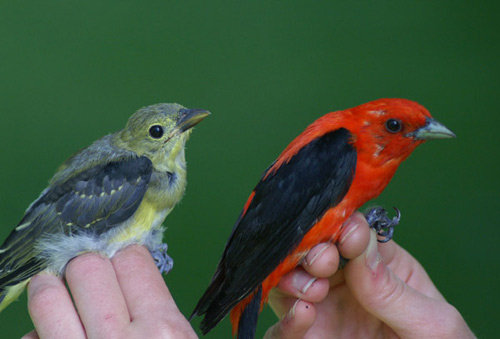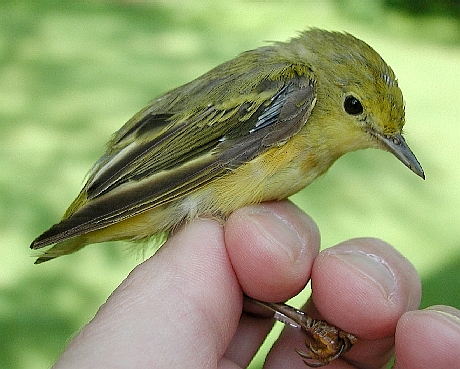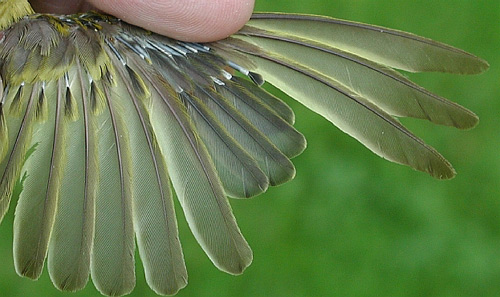June 2007

The first half of summer banding marked the transition between spring migration and the summer breeding season at Powdermill. By the end of the period, some adults were even showing signs that their nesting efforts for the year were done, as is typical for certain species.
In fact, it won't be long now before the first fall migrants will be on the wing and passing through. Because June is peak-breeding for many species, and daily turnover of individuals is low, the banding effort is scaled back and we operate less than half of the nets and band fewer days during the week (4-5). This resulted in a total effort of 18 banding days and 1,765 net hours.
In June we banded 274 birds of 40 species. The most common species were Cedar Waxwing (48), Red-eyed Vireo (31), American Redstart (29), Gray Catbird (24), Red-winged Blackbird (11), and Ruby-throated Hummingbird (11). The capture rate remained low with 15.5 birds trapped per 100 net-hours. We also processed 119 recaptures. The best day was 6/8, when 30 individuals of 11 species were banded, including our first Northern Parula of the year.
The sixth annual BioForay took place from June 13-16. The BioForay is a joint research and education project designed to assess and monitor patterns of biodiversity on a large study plot at Powdermill. This year for a change we set up some nets and banded near the BioForay plots.
Many thanks to volunteers Danilo Mejila, Maria Paulino, Mary Shidel, Pam Ferkett, Matt Shumar, Mike Allen, Logan Weygandt, Greg Baruffi, Michelle and Caleb Voithofer for their assistance with banding in June


Spring migration ended quite abruptly. Most birds captured during this period were local breeders, and there were fewer than the usual number lingering or straggling migrants. The last known migrant was a Northern Waterthrush banded on June 7 and retrapped on June 10th.
During the first half of the month, scattered juvenile birds began appearing in the nets, including our first HY Song Sparrow, Eastern Phoebe, Red-winged Blackbird (top photo to the left), and House Sparrow (bottom photo to the left).

On June 5, renowned Irish wildlife filmmaker, Éamon de Buitléar, had an opportunity to visit the Pittsburgh area and to spend a day at Powdermill observing the banding with his Pittsburgh friend Sam Neff, Jr.
Later on, they spent some time birding with PARC's Assistant Field Ornithology Projects Coordinator, Mike Lanzone. While not an especially productive day for banding or birding, as it was cool and rainy, we did manage to show our guests a fair number of new species and some of the scenic countryside around Powdermill, including Spruce Flats Bog and Ohiopyle State Park.
Éamon has produced many films, documentaries, and produced an award winning wildlife TV series, Ireland's Wild Countryside, which is consistently in RTÉ's (Radio Telefís Éireann, Ireland's equivalent of public television) top ten programs.
It was an honor to be able to spend the day with such an acclaimed Irish writer and filmmaker. Pictured below (from left to right) are Bob Leberman, Mike Lanzone, Éamon de Buitléar, Bob Mulvihill, and Sam Neff, Jr.

This Magnolia Warbler banded on 6/13 is an SY male, its dull plumage being the result of a comparatively limited first prealternate molt. Note its overall plumage similarity to the next bird.

This Magnolia Warbler banded on 6/20 is an unusually bright ASY female. Also unusual for so late a date, she was not in obvious breeding condition. Therefore, she was sexed by her morphology (the combination of a comparatively short wing length, <58.0mm, and dull plumage for an ASY), rather than by physiological evidence like a brood patch or visibly gravid condition.
As we have pointed out many times before on this website, it is the discrimination between young males and adult females in species with combined age and sex dimorphism that poses the greatest in-hand identification challenge for banders. In short, getting the sex correct requires getting the age correct. Of course, there would have been nothing wrong with banding this bird as an AHY-U.

Another oddly non-breeding condition female was this ASY female Indigo Bunting banded on 6/11.

This adult male Ovenbird in breeding condition was one of three banded in June.

On 6/21, Katie Lee led a workshop on drawing birds and feathers that was co-sponsored by Phipps Conservancy and Powdermill.
The group spent the morning in the banding lab observing and photographing birds up-close, and doing studies of individual feathers like the Chukar feather pictured to the left.


Bander-in-charge, Molly McDermott, shows a Red-eyed Vireo to the group (in the photo to the left, workshop leader, Katie Lee, is at top center).



The same day, we banded our first immature Carolina Wren (top), Yellow Warbler (middle), and Louisiana Waterthrush (bottom) of the year.
Compared to the “local” Yellow Warbler with its stubby tail and mouse-gray juvenal plumage, the Louisiana Waterthrush likely hatched several weeks before and had nearly finished its first prebasic molt. This species is one of the earliest breeding Neotropical migrants--many, if not most individuals begin heading south by the end of July.


Note: the color leg bands on the immature LOWA pictured above show that it is part of a larger focal study of the species at Powdermill that has been ongoing since 1996.
This summer, Dr. Steve Latta from the National Aviary joined the LOWA study as a principal investigator, and two field assistants with whom Steve has worked before in the Dominican Republic, Danilo Mejila and Maria Paulino (photo top to the left), very ably monitored LOWA pairs nesting on seven streams on and near Powdermill. They found and monitored more than 35 nests and banded nearly 100 adult and nestling birds, more than 20 of these in June.
Another summer avian research project at Powdermill was conducted by Michael Allen, an SY Master's student at East Stroudsburg University under the supervision of PARC Research Associate, Dr. Terry Master.
Mike worked on his second field season of data collection for his study of nest site selection and nesting success of Acadian Flycatchers in deciduous and hemlock forests. In the photo below right, Mike is checking one of his nests with mirror attached to an extensible pole.



This handsome ASY male Scarlet Tanager (top photo to the left; note the all black wings compared with the SY male wing close-up in the bottom photo to the left, which shows distinct prebasic and prealternate wing molt limits) was captured on 6/23 in a net with two juveniles, one of them young male (top and middle photos courtesy of Matt Shumar).

In the final week of June another locally hatched songbird, a White-eyed Vireo, was trapped seemingly right out of the nest, in addition to our first HY Barn Swallow, American Redstart, Downy Woodpecker, Black-capped Chickadee, and Ruby-throated Hummingbirds of the year.
On the first day of July, two new youngsters were banded--a House Wren and the "Local" Gray Catbird pictured to your left.


By mid- to late June, many adult songbirds at Powdermill, such as American Redstart, Black-and-white Warbler, Yellow Warbler, Chestnut-sided Warbler, Ovenbird, and Scarlet Tanager, already have begun their definitive prebasic molt.
Many of these are SY birds that likely failed at breeding or else were unsuccessful at acquiring mates or territories. Although it commonly is thought that there is little or no overlap between the energy-demanding nesting and molt periods for adults, at least some of the molting adult birds banded in June probably were still providing parental care to the fledglings that were caught alongside them in the net.
An SY female Yellow Warbler (photo to the left) was well along with her post-breeding molt, having dropped and begun replacing all twelve of her rectrices (tail feathers), her greater wing coverts, six primaries (and the corresponding priumary coverts), and three inner secondaries (second photo to your left).
Her molt progress, measured by assigning a value of 0-5 for each wing flight feather (0 = old; 1-4 = actively molting; 5 = freshly molted and fully grown), was 24 out of a possible 90 (i.e., completed molt, or the sum of molt scores = 5 for each of the nine primaries and secondaries), putting her in one of the most advanced molt stages of any bird caught during the period. Yellow Warblers not only molt very early, they also migrate earlier than most Neotropical migrants, with most departing their northern breeding grounds before the end of July.

This SY male Black-and-white Warbler had not progressed as far (molt score = 9) when it was banded on 6/27, but nonetheless was early compared to the average onset of molt in this species at Powdermill.

One of the many molting adult American Redstarts in June was this SY male (molt score = 9) with an interesting symmetrical black mask.
Because delayed plumage maturation of male AMREs (males do not acquire their definitive all black-and-orange plumage until their second fall) probably limits the nesting success of SY males, nearly all individuals of this age-sex class have begun molting before the end of June.

Although not yet molting when it was originally captured on 6/23, an SY male Veery (photo to the left) had just begun its molt (inner two primaries recently shed) when it was recaptured in the same net a week later. Veeries nest at higher elevations near Powdermill.
Similar to the lateral shift of many of Powdermill's forest-nesting songbirds into adjacent shrub-scrub habitats following breeding, many high elevation breeding birds drop to lower elevations (then into scrub-shrub habitats) shortly after nesting. This includes not only failed breeders, but also adults providing care to fully flighted fledglings that have followed them to lower elevations.

Finally, in June the great abundance of Tartarian honeysuckle berries flanking many of our net lanes were, as always, being greedily consumed by many species. As often discussed on this website, a red pigment (rhodoxanthin) in these berries is responsible for variant orange-tipped rectrices in Cedar Waxwings (and also orange plumage variations in other occasional or seasonal frugivores).
This is especially true for HY birds, whose first tail feathers are molting in at a time when adults are feeding their nestlings large quantities of honeysuckle berries. At Powdermill, adult waxwings usually do not molt until well after the honeysuckle fruiting season is over. An adult male waxwing banded on 6/27, however, was replacing accidentally lost belly feathers, and these were strongly tinged orange in contrast to their usual buffy yellow coloration.
